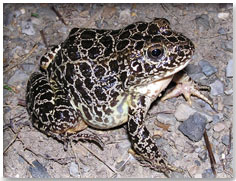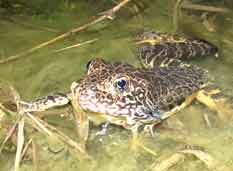 Description
Description
2 ¼-4 ½” (5.7-11.4cm). Large and chunky body with distinct humped back when at rest. Its body is covered in dark spots with light borders. Its belly is white without spots. Males have two vocal sacs, one on each side of the jaw.
Call Description
Male crawfish frogs produce a loud, deep, resonant snore repeated at irregular intervals during the mating season. It can be heard from over a mile away under good listening conditions. Large choruses may sound like hogs at feeding time or a distant motor speedway.
Indiana Range
Crawfish frogs historically occurred in western Indiana from Benton County south to the Ohio River. The species has declined along the northern and eastern edge of its range, with current populations remaining in the southwestern quarter of the state, with very few populations south of the White River. An isolated but large population occurs in southeast Indiana. Crawfish frogs are state endangered.
Diet
Nocturnal beetles, spiders, earthworms, ants, and millipedes.
Habitat
Occupies upland crayfish burrows in moist meadows, prairies, and grassy fields.
Breeding Habitat
Occupies upland crayfish burrows in moist meadows, prairies, and grassy fields.
Breeding Season
March through mid-April.
Eggs
Large, round masses of 3,000 - 7,000 eggs attached to vegetation.
Tadpoles
Brown to greenish, sometimes with small spots. Very similar to southern leopard frog tadpole.
Conservation Notes
Crawfish frogs spend much of their lives in their burrows, resting inside the burrow or just outside the burrow entrance where they bask and feed. During cold weather or extreme heat, crawfish frogs retreat underground to maintain proper body temperature and moisture levels. When suitable weather returns, the frogs emerge from their hideaways and may be active on the surface during any month of the year, if weather conditions are good. Each spring, crawfish frogs migrate to breeding ponds to mate and lay their eggs. Remarkably, the frogs can migrate back to their original burrow, which may be over a half mile away. Their close association with crayfish burrows and long migration distances highlight the importance of managing grassy, untilled habitats where crawfish frog populations still exist.
